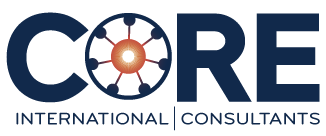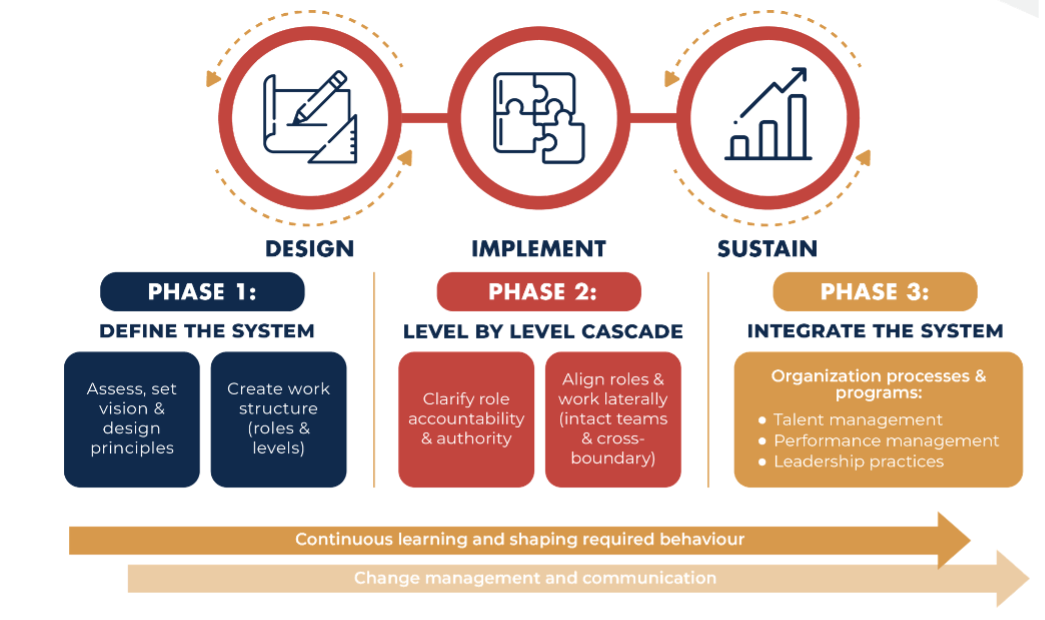A 3-phase approach
The overarching mantra of organization design experts is form follows function and an organization’s structure must be aligned with its strategy. In other words, an organization’s design and structure should support and enable employees to carry out the work necessary to achieve the strategy, not get in their way.
The amount of restructuring an organization requires depends on the degree of change to the strategy. When only tweaking the strategy, it is best to determine the areas of the business that will be impacted, identify required changes and test how those changes will impact the rest of the organization, and then make the necessary adjustments. If the strategy represents a significant change in what the business does and how the business is carried out, then a wholesale change to the organizational structure will be required.
If there is a significant change to strategy, how do we get there?
Successful strategic organization design encompasses three equally important phases:
Phase One: Define the system – Develop design criteria and models
At the highest level, a new strategy may require the sale or shutting down of units, acquiring new business, building new capabilities, and realigning work. The place to start is to answer the questions–What work should the organization structure enable? What are the key strategic imperatives that must be achieved and what roles are required to carry out that work? Answering these questions will facilitate the development of design criteria outlining the attributes the new organization must have to successfully execute the strategy. Once leaders agree on these criteria then the detailed work of designing the organization can begin.
Models are developed based on the design criteria. Each model is a high-level organization design outlining roles and accountabilities in a way that will support strategy execution. Senior management’s job is to determine which model best fits the organization in terms of execution, cost, and culture. Often the final organization design is made up of elements of two or more models that are determined to best enable employees to deliver the strategy.
Phase Two: Implementation – the level-by-level cascade
Once a model has been finalized the detailed work of “fleshing out” the organization begins. Leaders take the high-level organization design and identify the roles required, cascading the structure down to the frontline. Final decisions are made regarding the number of layers required, the grouping of functions, and the nesting of systems, and processes. The organization will have new roles but will also retain many roles that currently exist, although the work of these roles may change.
Role clarity involves cascading role definition down through the organization in a way that implements the new organization structure and roles permanently.
Leaders throughout the organization will need to answer the following questions:
- What is the critical work that we are not doing today but that needs to start?
- What work needs to continue or adapt?
- What work needs to stop?
Roles are then built out with high-level accountability, decision authority, and cross-boundary role relationships that will enable managers to map employees to roles and identify if additional talent needs to be acquired. Undertaking this work ensures that the entire organization is aligned with the new strategy, allowing the organization to deliver the future and not remain stuck in the past.
Phase Three: Integrate the system
The final phase is focused on integrating and aligning the structure and managerial system with talent acquisition, talent management, learning and development, total rewards and recognition, and leadership practices. Bake the structure and managerial system so that they are sustainable over time and remain aligned with the business strategy.
Michael Brush
As a partner with Core International Inc. since 1997, Michael Brush has worked with many of Canada’s largest companies in structuring to deliver strategy and improve performance. For more information on how Core International can help you get the best out of your business, book a call to talk things over here, contact Mike at mike@coreinternational.com or call 416-977-2673 ext. 13.

